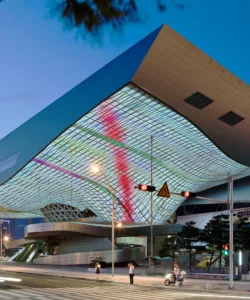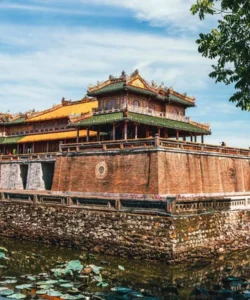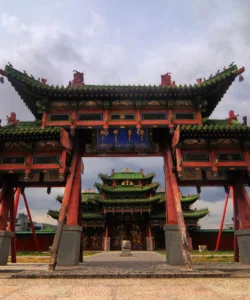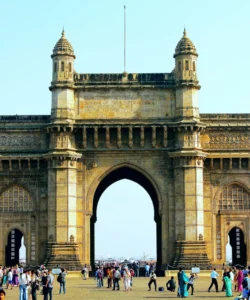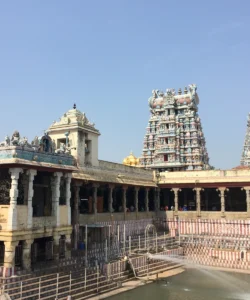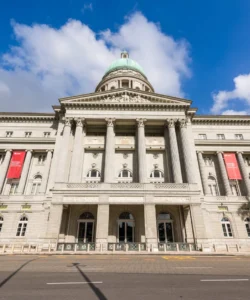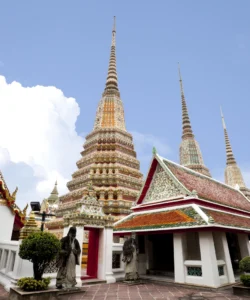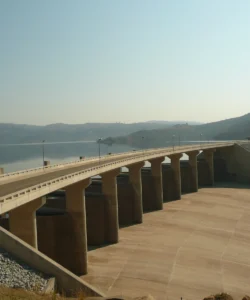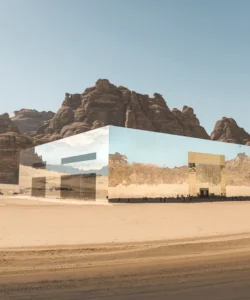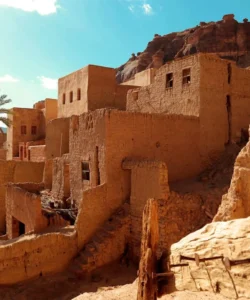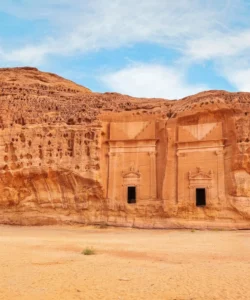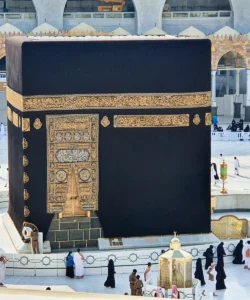Swayambhunath, often affectionately known as the “Monkey Temple,” is one of Nepal’s most ancient and sacred religious complexes. Perched atop a hill in the Kathmandu Valley, it offers a profound spiritual experience, an architectural marvel, and breathtaking panoramic views of the city.
Name: Swayambhunath (Devanagari: स्वयम्भू स्तूप; also called Swoyambhu, Swayambhu Maha Chaitya, Swayambhu Stupa, and popularly, the “Monkey Temple”)
Address: P.O.Box No: 44600, Kapurdhara Marg – 26, Kathmandu, Nepal. It is situated on a hillock about three kilometers west of Kathmandu city center.
How to Get There:
Swayambhunath is a prominent landmark and easily accessible from Kathmandu:
- By Taxi/Ride-Sharing: This is a convenient option for a direct drop-off. The drive from central Kathmandu takes about 15-20 minutes, depending on traffic.
- By Local Bus: Public buses are a very affordable option and can take you close to the base of the hill.
- Walking: For those staying nearby or in central Kathmandu, it’s possible to walk (approx. 40 minutes to an hour), offering a chance to experience local life along the way.
- Two Access Points:
- Eastern Stairway: The most iconic approach involves climbing a steep stone staircase of 365 steps (or 312 steps to the main platform). This is the traditional pilgrim’s route and offers a dramatic ascent.
- Southwest Entrance (Vehicle Road): There’s a vehicle road that circles the hill to the south, leading to a parking area near the southwest entrance. This offers easier access for those who prefer to avoid the steep climb, though there are still some steps to reach the main stupa.
- Entrance Fee: There is an entrance fee for foreign nationals and SAARC nationals. Nepalese citizens and children below 10 are usually free.
- Dress Code: As a sacred site, modest dress is required (shoulders and knees covered). Footwear must be removed before entering the main stupa platform.
- Best Time to Visit: Early morning (before 9 AM) offers cooler temperatures, fewer crowds, and the chance to observe pilgrims performing rituals. Late afternoon/sunset is also magical, as the stupa glows and butter lamps are lit, creating a serene and vibrant atmosphere.
Landscape and Architecture:
Swayambhunath’s architecture is a significant example of Buddhist stupa design, intricately adorned with symbolic elements and surrounded by a complex of diverse shrines, all set on a sacred hilltop.
- Hilltop Location: The complex is situated on a prominent hill, offering panoramic views of the entire Kathmandu Valley, which legend says was once a large lake.
- The Main Stupa: The central and most iconic structure is the great stupa (Maha Chaitya). It comprises several key elements:
- White Dome: The massive, solid, whitewashed hemispherical dome at the base represents the entire world or the universe.
- Harmika (Cubical Structure with Eyes): Above the dome is a cubical structure (the harmika). Each of its four sides is painted with a prominent pair of Buddha’s “all-seeing eyes” (representing wisdom and compassion) and a third eye (symbolizing omniscience). Between the two eyes, where a nose would be, is a curly symbol, the Nepali character for the number 1, symbolizing the unity of all things and the one way to reach enlightenment (through Buddha’s teachings).
- Thirteen Tiers (Trayodashabhuvana): Above the harmika, a gilded spire rises in thirteen concentric rings or tiers. These represent the thirteen stages or steps of spiritual realization that sentient beings must pass through to achieve enlightenment or Buddhahood.
- Gajur (Finial): The very pinnacle is topped with a gilded finial (gajur), often made of copper and gold, symbolizing the jewel of Nirvana.
- Toranas: Above each of the four sides with the painted eyes, there are pentagonal toranas (ornate gateways) with statues of the Pancha Buddhas (Five Dhyani Buddhas).
- Prayer Wheels: Encircling the base of the stupa are numerous large prayer wheels, inscribed with Buddhist mantras (like “Om Mani Padme Hum”). Pilgrims traditionally walk clockwise around the stupa, spinning these wheels, a practice believed to accumulate good karma.
- Vajra (Thunderbolt): At the top of the eastern stairway, just before the main platform, stands a massive, gilded Vajra (thunderbolt or Dorje), a powerful symbol of indestructible wisdom in Vajrayana Buddhism.
- Diverse Shrines and Temples: The complex includes a variety of other structures, reflecting Nepal’s religious harmony:
- Harati Devi Temple (Ajima Temple): A two-tiered pagoda-style temple dedicated to the Hindu goddess Harati, who is revered as a protector of children. She is worshipped by both Buddhists and Hindus.
- Pratappur and Anantapur Temples: Two tall, slender pagoda-style temples built by King Pratap Malla in the 17th century, flanking the central stupa.
- Dewa Dharma Mahavihar: A large monastery displaying a bronze Buddha icon and traditional Tibetan paintings.
- Various Smaller Stupas, Chaityas, and Statues: Scattered throughout the complex.
- Monkeys: The “Monkey Temple” nickname comes from the hundreds of rhesus macaques that live freely around the complex, adding a lively and sometimes mischievous element to the visit. They are considered sacred.
What Makes It Famous:
- UNESCO World Heritage Site: Designated a UNESCO World Heritage Site in 1979, Swayambhunath is recognized for its outstanding universal value as one of the oldest and most sacred sites of Buddhist art and architecture.
- All-Seeing Buddha Eyes: The iconic painted eyes on the stupa’s harmika are instantly recognizable globally and symbolize Buddha’s wisdom and compassion watching over the world. They have become a symbol of Nepal itself.
- Ancient Origins and Mythological Significance: Legend states it emerged spontaneously from a primordial lotus in a lake that once covered the Kathmandu Valley, earning its name “self-emerged.” This ancient history and powerful mythology contribute to its profound spiritual significance, believed to date back over 2,500 years (though archaeological evidence suggests 5th century CE).
- Religious Harmony: Swayambhunath is a remarkable example of religious harmony in Nepal, revered by both Buddhists (especially Newar and Tibetan Buddhists) and Hindus, with both faiths worshipping at its various shrines.
- “Monkey Temple” Nickname: Its large and active population of rhesus macaques makes it a unique and memorable interactive experience, giving it its popular nickname.
- Panoramic Views of Kathmandu Valley: Its hilltop location provides breathtaking 360-degree panoramic views of the entire Kathmandu Valley, making it a prime spot for photography, especially at sunrise or sunset.
- Vibrant Spiritual Atmosphere: It is a living, active pilgrimage site, constantly filled with the sounds of chanting, the scent of incense and butter lamps, and the sight of devotees spinning prayer wheels, creating a deeply immersive spiritual ambiance.
Differences from Some Other Wonders:
- Iconic Painted Eyes on Stupa: While other Buddhist stupas exist globally (e.g., Shwedagon Pagoda in Myanmar, Borobudur in Indonesia), Swayambhunath’s prominent and uniquely painted “all-seeing eyes” on all four sides of its harmika are its most distinguishing visual feature, immediately setting it apart.
- Hindu-Buddhist Syncretism (Explicitly Multi-Faith Site): Unlike purely Buddhist sites (like Borobudur or Ajanta) or purely Hindu ones (Prambanan, Meenakshi Amman Temple), Swayambhunath explicitly and visibly incorporates shrines dedicated to both Buddhist and Hindu deities within the same complex (e.g., Harati Temple), showcasing active multi-faith worship in a way that is less common for such a prominent single monument.
- Monkeys as Integral Part of Experience: While monkeys are present at some other sites (e.g., Uluwatu Temple, Sacred Monkey Forest in Bali), their sheer number and their very visible, often mischievous presence as “sacred residents” at Swayambhunath is a central, defining, and interactive aspect of the visitor experience.
- Hilltop Location with Dual Access: Its strategic hilltop placement, offering commanding views, combined with the two distinct modes of access (the long, symbolic eastern stairway vs. the road access from the southwest), creates a unique arrival experience.
- Architectural Symbolism (13 Stages to Nirvana): The clear and explicit symbolism of the 13 tiers of its spire representing the 13 stages to Nirvana is a direct and famous interpretation of its architectural form, making its spiritual meaning immediately tangible.
- Less Focus on Massive Bas-Reliefs/Sculptures: While it has sculptures, Swayambhunath’s fame is not primarily driven by the sheer volume or narrative complexity of bas-reliefs or hundreds of statues as seen in places like Borobudur, Prambanan, or Angkor Wat. Its visual impact is concentrated on the stupa itself and its immediate surroundings.
Swayambhunath Photos:































